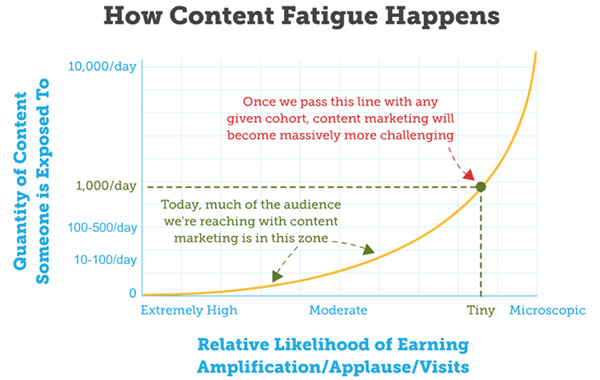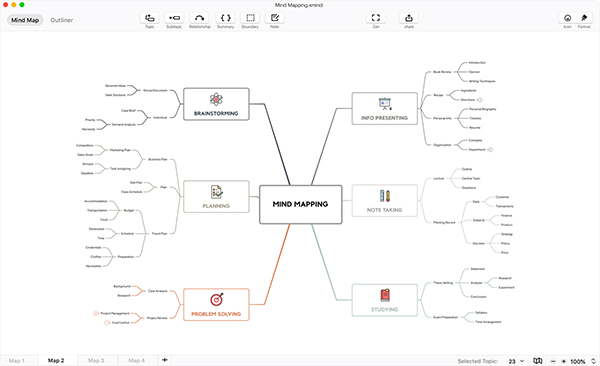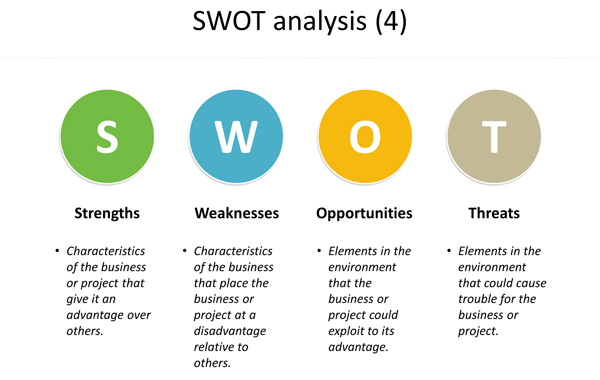Home » Content Marketing » Beyond Brainstorming: 5 Creative Activities to Help Spark Fresh Content Ideas

Beyond Brainstorming: 5 Creative Activities to Help Spark Fresh Content Ideas
Your content writers are your creative powerhouse. And aside from building a sustainable team, you need to feed them with good ideas on an ongoing basis.
However, creating cadence in your blog management is far from being easy. It’s an all too common problem. We get tired, somewhere along the line, of churning out content ideas.
Everyone in the business can relate.
But so can our online audience. With over 5 million blog posts published every day, it’s no surprise our readers experience content fatigue.
Here’s a diagram from Moz that explains the situation.

Source: moz.com
While the consequences of content fatigue are unfortunate, you can still do your best to create some awesome blog content.
We bring you 6 creative activities to help you spark fresh content ideas.
1: Zero Draft Technique
The first obstacle you face when coming up with ideas for your blog is the infamous writer’s block. But have you ever wondered where this frightful phenomenon stems from?
As a writer, your job is to create content for public consumption. And as human beings, we’re sensitive to other people’s judgment.
According to Jeff Goins, the best-selling author:
“Writer’s block is an excuse. Nothing more. It is a creative person’s pre-emptive defense against judgment. It is a wall between ourselves and the public.”
A Zero Draft technique can help get this internal conflict out of the way. It’s an ideation technique commonly used in literary circles. But content marketers and e-commerce writers are free to use it for their own purposes.
The very point of this technique is to put your initial ideas on paper. So, your Zero Draft will help you make a dent in the early stages of your work.
For example, you might want to create topic clusters around specific keywords.
Below are the steps that will help you explore your target topic and come up with blog ideas:
- Think about why your topic is important.
- Write out all the ideas from the top of your head, including the details you know about the subject.
- Write out whatever it is that you want to learn about the topic further.
- Write out any ideas that are popping out in your head. Put them down on paper without much critical consideration.
2: The Fake Interview Exercise
Do you want to try and plan your blog posts in a less rigid, more flexible way? If so, then you should give this brainstorming exercise a spin.
The Fake Interview exercise takes you down the path of unconventional content ideation.
Tapping into your creative capacities while in a diffuse mode of thinking can be a powerful marketing device. When you’re in a relaxed state of mind, you’re able to create random connections. And that’s where the magic happens.

Source: 7pace.com
Here’s how the exercise works:
- Imagine an influential figure interviewing you for a podcast, radio or a TV program.
- Jot down a few jump-start questions.
- Stage the back and forth communication in your head.
- Type the conversation into your computer as you go, leaving some notes and hints.
Once you’re done (and you should expect this exercise to yield a few writing pages), review your points. Odds are you’ll end up with ideas worth writing about.
3: Brain Netting Online
Brain Netting is a great option when you need to quickly brainstorm ideas within your team.
This brainstorming exercise leans heavily on new technologies. And this, in turn, enables you to include your remote employees as well.
This is how it works:
- The whole team connects electronically (via your Slack, Google Hangouts, or Flock chatroom).
- Then you get everyone to chip in and help with content ideas for a given project.
- Each chatroom member votes for their favorites.
- The team works together to combine the best ideas into what’s going to be the end product.
In a nutshell, brain netting allows you to enjoy the input of your entire team. Plus you avoid wasting time and resources on the back and forth communication (e.g. via email).
You can take this collaborative experience to the next level by using mind-mapping tools, such as XMind. These tools allow for more creativity since they allow you to map your ideas out visually.

Source: xmind.net
4: Content Brainstorming Matrix
Content Brainstorming Matrix is a handy activity for marketers that are riding solo.
In this game of combinatorics, all you need is a spreadsheet and a little bit of data entry. What you get are some fresh content ideas.
The brainchild of the HubSpot team, this activity allows you to use a template to get content ideas fast. It facilitates the writing process as well since the writers know exactly which stage of the funnel they’re targeting.
There are five steps to follow:
- Step 1. Start with a blank spreadsheet. Write down your main topic (e.g., Teaching a language, Learning SEO).
- Step 2. In the next row, state whether your blog post is aimed at the top, middle or bottom of the funnel audience.
- Step 3. In the next step, decide on the type of content you want to use (e.g., comparison article, pillar page, how-to article)
- Step 4. Come up with the article format (e.g., blog post, checklist, podcast, infographic, video)
- Step 5. Use the spreadsheet to generate content ideas.
5: S.W.O.T. Analysis
S.W.O.T. Analysis is a term businesses use to analyze Strengths, Weaknesses, Opportunities, and Threats before venturing out into a new project. Yet, you can use this strategy in your brainstorming sessions to help you sift your ideas through.
It doesn’t have to be anything fancy.
You can scale down the concept and simplify S.W.O.T. Analysis when generating your blog ideas.

Source: yourfreetemplates.com
For example, you can analyze your content marketing strategy by using this technique. It’s as simple as creating four simple S.W.O.T. columns and taking notes as you go.
As you’re reviewing your existing blog content, ask yourself the following questions:
- What makes your current content stand out (strengths)?
- In what aspects can your content improve (weaknesses)?
- Is there a fun new strategy you’ve discovered recently that you can use for the project at hand (opportunities)?
- Are there any serious errors that can put your blog at risk (threats)?
This strategy not only yields you some fresh, unique ideas for your projects. It also helps you build on your strengths and weaknesses. So give it a go.
Ready to Cook Up Some Fresh Content Ideas?
Coming up with a steady stream of content ideas doesn’t have to be your tragic fate. Sure it is a source of great anguish when you’re time-pressed for some fresh content ideas. But, it’s grunt work only if you allow it to be.
Use the five creative activities above as your go-to source whenever you need to light the creative spark and get those ideas rolling. Or better yet, outsource this laborious process to experts that deliver flawless content every time you need it.
CopySmiths
I'm Katrina McKinnon, founder of CopySmiths and Small Revolution. In my 20 years of experience, I have helped online businesses create high-performing content specifically on an eCommerce store's blog. Find me on LinkedIn and Twitter.

CopySmiths offers the best blog writing services for online stores.
If you'd like us to write blog articles for you, click here.
Most Recent
- 3 Bold Questions You Should Ask When Hiring A Content Writer

- 5 Practical Reasons You Should Use a Blog Post Template

- 4 Amazing Benefits of Using a Title Generator for New eCommerce Blogs

- 10 Awesome Bio Examples Your Online Store Blog Should Emulate

- 8 Basic Steps to Successful Content Development Every Time

Podcasts
Got a question?
Ask our friendly team about our article writing services.
Subscribe to CopyZine
Monthly, hand-picked stories of the best in eCommerce Content.




